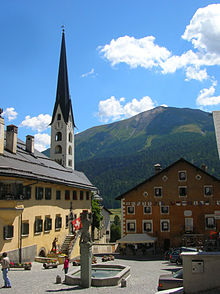Engadin theater history
The Engadin theater history is first and foremost the history of the people's theater , which in the inner alpine high valley of the Engadine dates back to the 16th century.
The beginnings up to the 17th century
During the Reformation , dramas were staged everywhere in Rumantschia , most of which were based on biblical narratives . The humanist Gian Travers from Zuoz was the first political publicist to use the Upper Engadin language , the turkey, from 1527 onwards , and who also worked as a playwright. In 1534 his play “La Histoargia dal bio patriarch Josef” (= The life story of Patriarch Josef ) was premiered on the village square in Zuoz .
The lawyer Jachiam Tütschett Bifrun got the first translation of the New Testament into the Puter, the Upper Engadin language; it was published in 1560. The reformed pastor Durich Chiampell translated psalms into the Vallader , which were published in 1562. Chiampell's plays "Giuditta e Holofernes" (= Judith and Holofernes ) and "Joseph, Figl d'Israel" (= Joseph, son of Israel ) were staged in 1554 in the Lower Engadine town of Susch . Both plays were religiously motivated. In contrast, the piece “Las dysch aetats” (= The Ten Ages ) by Bart Stuppan , which was played in Ardez soon after, was primarily interested in politics.
The turmoil in Graubünden in the first half of the 17th century with its devastation of the villages brought the Engadin theater to a virtual standstill for decades. In the second half of the century, a theatrical detective piece "Il saltader dils morts" (= The pledge of the dead ), which was originally written in Sursilvan before it was transferred to the Ladin , has been handed down.
18th and 19th centuries
The 18th century was a time of lack of creativity. Instead, plays were imported from nearby Tyrol . It was not until the founding of schools in the middle of the 19th century, supported by the young canton of Graubünden , that the Engadine theater was revived in the form of the now flourishing school theater .
The commemoration celebrations of 1899 on the occasion of the 400th anniversary of the Battle of Calven were accompanied by a renaissance of patriotic open-air games . Otto Barblan's music underpinned the Engadine Romanesque memorial “Chalavaina”, which is performed in many places in the canton.
20th century
In 1944, Jon Semadeni founded the touring stage “La Culissa”, which played dramatic pieces primarily in the Engadin, but also in Chur , Zurich and Bern . In 1951, Semadeni founded the cabaret group “La Paniglia” with Cla Biert and Men Rauch . In 1945 Tista Murk established “La Scena”, a publishing house for Rhaeto-Romanic theater literature.
In 2000, in Zuoz, on the historic village square, La svouta - the turn of Jacques Guidon was performed. The piece refers to the person and work of Gion Travers and aims to “go back into the past”.
present
Currently (as of 2011) eight Engadine theater groups are members of the Bündner Vereinigung für Volkstheater . One of the largest is the Samedan Dramatic Theater . In 2010, the dramaturge and theater director Giovanni Netzer staged the play “La regina da Saba” (= The Queen of Saba ) at the top of the Julier Pass . In December 2011, its own theater, the Zuoz Globe , was opened in the Lyceum Alpinum Zuoz , which is the first in the Engadin and mainly features plays by William Shakespeare .
literature
- Maya Höneisen: The theater as a recipe for promoting Romansh. In: Die Südostschweiz, September 14, 2011, p. 9.
Individual evidence
- ↑ Constant Wieser: Travers, Johann. In: Historical Lexicon of Switzerland .
- ^ Ottavio Clavuot: Bifrun, Jachiam. In: Historical Lexicon of Switzerland .
- ^ Conradin Bonorand: Campell, Ulrich [Duri Champell]. In: Historical Lexicon of Switzerland .
- ↑ Maya Höneisen, see under literature
- ^ Theater & Zuoz Globe on the website of the Lyceum Alpinum Zuoz.
